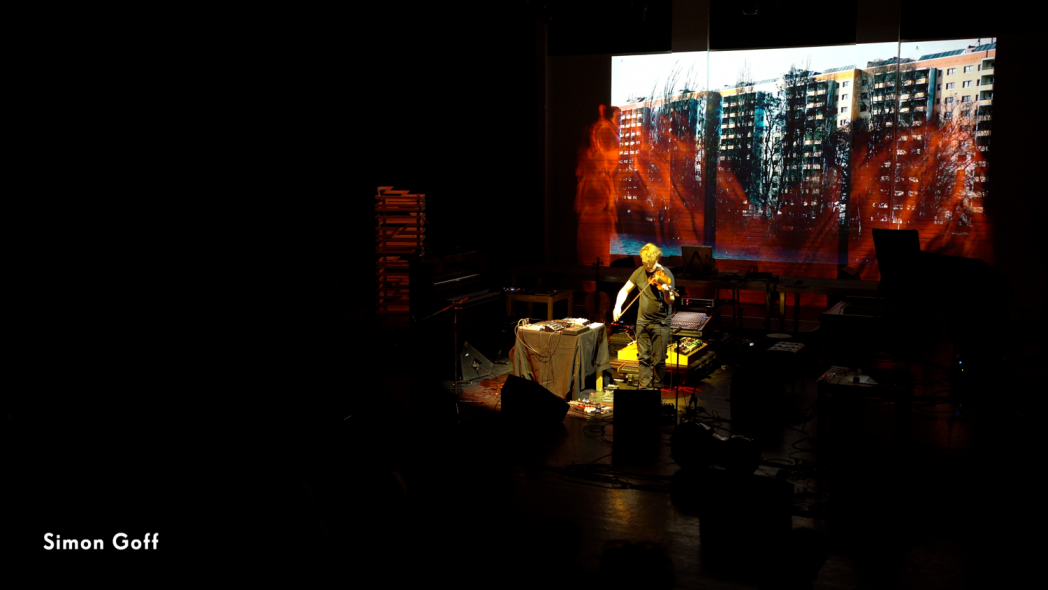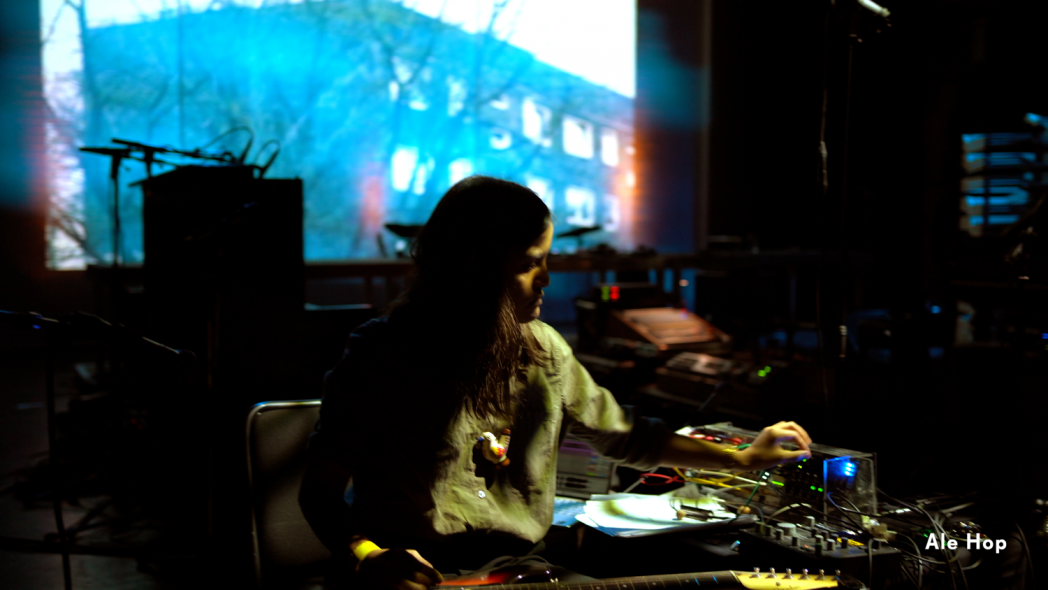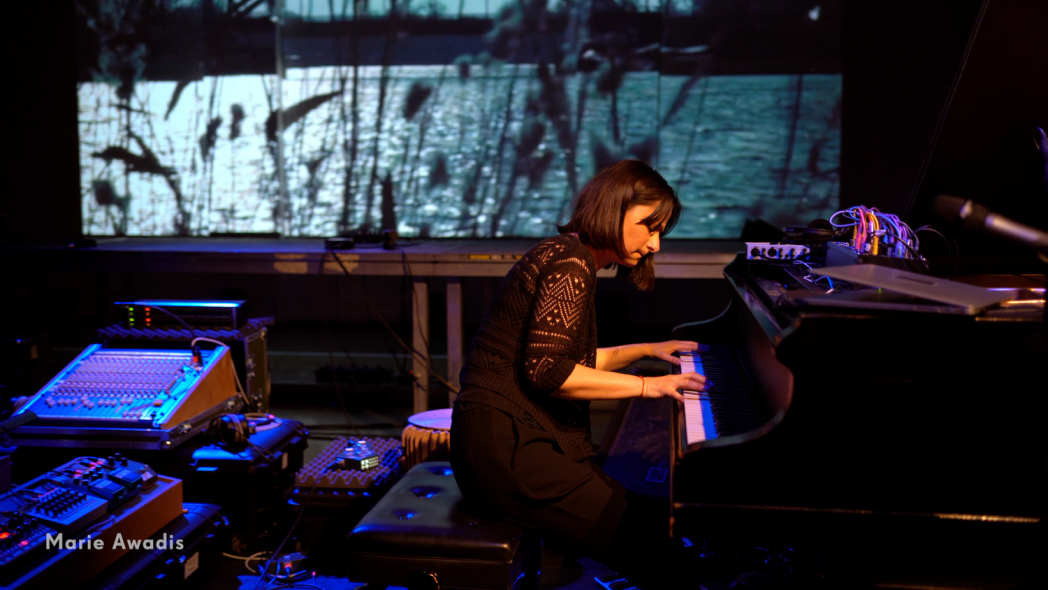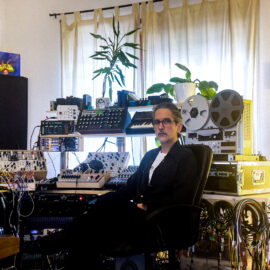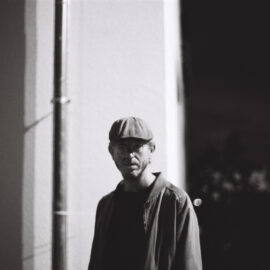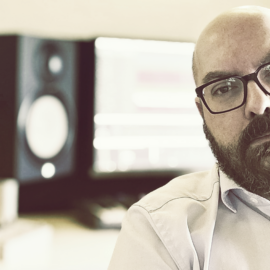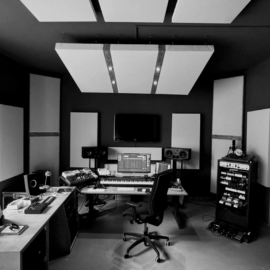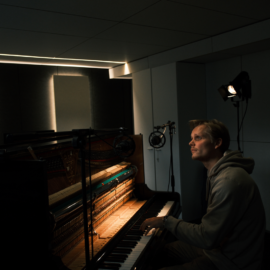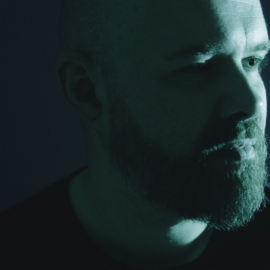Editor’s Note: The following interview is about a music festival curated by East Berlin-born multi-instrumental composers Sebastian and Daniel Selke, who you may also know as Brueder Selke and CEEYS. This year, the festival will take place between June 2nd and 4th in Potsdam. You can get more details and tickets here. The duo has also curated a mix for Headphone Commute Podcast, showcasing the pieces that traverse the upcoming lineup. I recommend that you listen to it in the background as you read this interview about the festival. All the photos in this article are from last year’s (2022) performances by Victoria Harster.
Can you tell us where the name Q3Ambientfest comes from?
We grew up in “Europe’s biggest Plattensammlung” – in the East-German Plattenbau district Marzahn-Hellersdorf. [Translator’s note: The German word Platte can refer to both vinyl records and the prefab concrete slabs of the distinctive East-German apartment blocks.] The architecture there has left a lasting impression on us. That’s why our first two album duologies under the alias CEEYS contained allusions and reflections – and above all, authentic photos – of this so-called “brutalist” building type. But for us, they were not just monotone grey geometric shapes but also the location of our first musical exercises.
It’s no coincidence that the last CEEYS duology “Hausmusik”, and the rework album, “Musikhaus”, pick up specifically on this meaning of our old flat and place of training, which we find very relevant – from the quiet house or chamber music within our “own four walls” to a house full of music.
Q3A is the architectural shorthand for the first three, four and five-storey series of pre-fab buildings in the GDR in the 50s and 60s of the last century. “Simply put”, it means: Querwandtyp, Number 3, Variant A… And this is where everything began with the cello and piano… Other series included the QP and also the QX…
Together with the discerning label Oscarson, we released two special 7-inch EPs dedicated to Q3A and QP. These again take up the theme and are designed to explore our work as a long-term collaborative duo in an original way – from solo and duo pieces to a “hidden track” in each that only appears by overlaying the music from the A and B sides.
Is there a central theme to the aesthetic of the festival?
As children, we first practised alone, then together in a poorly soundproofed Plattenbau. Through the paper-thin walls purposely planned and cheaply built by the East German dictatorship, we could hear each other so well that we, on top of sympathising with each other’s suffering through their exercises, also developed our first improvisations. Alongside the one or other Cowboy-and-Indian battle that had to be fought out on the home carpeting with little toy figures, the unfailing sensitivity and, above all, sense of humour in our, at times, “combative” interplay definitely had its origins there.
But generally, too, as children who grew up behind the wall, for us, it’s above all about encountering and exchanging with like-minded people, colleagues, and music lovers.
So it’s no coincidence that the stage setup is designed like a playground. Back then, it was always a meeting place, an island, and, as such, a haven for free thinking. Towards evening, the surrounding concrete buildings that normally felt so massive became an oversized world of geometric shapes.
Inspired by them to this day, we have developed a fitting visualization that shows the still-life of that architectural landscape. These have been subtly extended and stretched here and there by film and video artist Sal Vanegas with time-based effects and are intended to animate the performing artists during their individual sets to respond sensitively to the pictures on the big screen – so, to create a kind of musical score.
How do you approach selecting the artists who are featured each year?
With the curation, we focus primarily on established but also emerging experimental music projects that are searching for an original personal language. A “healthy mix of both” is, for us, the golden mean, and it’s been nice to see that some of our now better-known colleagues took their first brave steps upon our stage. So we’re also interested in, especially in these early exploratory stages, the trying out of new playing techniques and sounds.
We have hope and trust that through all these different and, at the same time, authentic musical approaches, we can also possibly better understand and creatively reflect the larger relationships that shape, change, and in their contradictions, hold together our world.
We hope that our approach comes across, so to speak, so that everyone feels encouraged to get in touch with us, to explore ideas and visions, and, in the best-case scenario, to transfer the artistic results of this process onto the stage.
It’s definitely an advantage that we, as a duo, are ourselves on the road to exploring and making use of the crossovers between traditional and contemporary music. Our own setup should, above all, be able to be played intuitively and in real time by hand or foot, so without computer sequences. We look for similar approaches in our curation.
First and foremost, we listen when the possibilities of the playing techniques and sounds of traditional string and key instruments are tested. For us, that’s top tier, when there’s a kind of communication beyond time, into the past, the present, and the future. We also still haven’t found the “Holy Grail” yet, but maybe it’s much more about the exchange itself. At least that’s – as we’ve implied a few times – our driving force. And in the end, curation is primarily about “conservation and care”; both sides determine the selection process.
What about the visual aspect of the festival?
We grew up in East Berlin, and in our hearts, we remain closely connected to this cultural metropolis. This cosmopolitan city has shaped us from our earliest childhood. With the move of the Deutschen Filmorchester (German Film Orchestra) – in which Sebastian leads the cellos as acting principal cellist – from Funkhaus Berlin to Studio Babelsberg, the idea came up to maybe move to Potsdam. When Daniel also found work here, we finally decided to set up the Klingenthal Studio in Potsdam.
Since our primarily instrumental music is often compared with film music, it’s hardly surprising, and it’s fitting too, to present Q3Ambientfest in this historically and architecturally multifaceted “film city” since a mix can also be found here of the magnificent palaces of Fredrick the Great, classical-baroque residences, and brutalist Plattenbaus.
How do you go about picking the best venue?
Over the years, we’ve played countless fascinating venues – from cosy clubs to churches with reverb that lasted seven seconds, from labyrinthine vaulted cellars to immense festival stages. Though we don’t have a “favourite”, we are always searching for that open, sincere atmosphere between musician and audience. You know, we’re working on two albums where exactly this concert atmosphere could be captured, even though the two spaces could not have been more different.
This year we will be in the Kesselhaus vom Waschhaus in Potsdam for the first time, and therefore in a real concert venue – with the most professional audio equipment and, above all, a team with a high level of expertise and technical knowledge. That was almost unthinkable in 2020. We’re starting afresh here and focussing our energy and inspiration on this space.
On the one hand, we try to bring the world to Potsdam and create suitable and welcoming spaces for music-based projects. On the other hand, we love receiving invitations from colleagues who have played with us, inviting us into their world.
What is one of the most challenging aspects of organizing a festival?
The aspect with the greatest potential for conflict is time management. With Q3A, we wanted, despite the extraordinary challenge of having very limited time, to give ourselves the necessary space and time to really extensively familiarise ourselves with the creative process of our colleagues. Only in this way can there be new impulses for us on and off the stage.
And what about the most rewarding experience?
We not only get to know interesting projects and wonderful new colleagues but can apply lots of techniques in the context of the organisation. As curators who also compose and perform, the Q3Ambientfest always gives us new hope to keep going. We enjoy recognising the parallels between our own creative process and those of our colleagues and keep optimising the workflow in order, ultimately, to be able to direct a focus onto the music that’s free from distraction.
It’s like a “musical epiphany”, after years of traditional academic study in classical music, at the first edition in 2017, diving into spontaneous improvisation with musicians.
That really was an ultimate spark, and that’s why it’s part of almost all of the concert formats that we curate – a moment that’s not captured on tape or film but that stays in our hearts because it showed us that beyond all language barriers, just the dialogue between instruments could and still can allow a personal communication…
Most of our colleagues we only know virtually. Of course, this circumstance also has its advantages, namely being able to talk shop quickly and across all distances. But after we had realised some orchestral projects in the classical hemisphere, it made sense to try to start meeting like-minded people on a common, physical stage.
What are some of the unexpected projects, relationships, or special events that culminated as a result of Q3Ambientfest?
We’re working on a collaboration with one of our favourite artists, Midori Hirano. With her, we’re also playing one of the evenings curated by us in Leuven as part of “Piano Day”. Aside from that, there’s also an exciting, expansive studio album planned on Aimée Portioli’s label “One Instrument”, on which our restored GDR synthesisers, string machines, and organ will exclusively be heard.
Further, the Q3Ambientfest was recently able to organise a collaboration with the Ambientfestival in Cologne and streamed a performance from Volker Bertelmann.
As musicians who on our releases continuously grapple with our childhood, we are currently working on a project in cooperation with UNICEF Potsdam.
Live music has been affected by COVID the most. How did the festival cope during that time?
The last two years developed very suddenly into an existential challenge. On the other hand, we once again came to the realisation of which aspects of discipline and freedom ultimately remain essential in music.
In 2020, we were on the verge of giving up on all our projects, including the Q3Ambientfest. But apparently, no one wanted to really believe or even accept that. On top of that, we received heartening encouragement from the city of Potsdam.
And somehow, we were also suddenly “in our element” as we faced the question of how our festival could be “transformed”. So the Q3A was finally able to take place virtually in the lockdown years, and since then, this video approach has become a permanent part of our programme.
If you could predict the future, what would Q3Ambientfest look like in 10 years?
In the beginning, it was a small circle of idealistic musicians who we quickly got to know online through our first release on David Wenngren’s “1631 Recordings” and wanted to invite in person. In 2016 – as we mentioned – we moved to Potsdam. Barely a year later, our idea was born to develop a bespoke music fest. We finally realised this little dream out of our own pocket in 2017 with the first edition. Every year we have met new, inspirational colleagues who, in turn, motivate us to continue.
Over the last decade, ambient music has become a pool of musical diversity. It’s finally becoming more about a basic feeling of freedom, a natural need and an experimental environment.
Each musician should be put in a position where they feel so comfortable in their environment that they can, using their understanding of “contemporary music”, say that which moves them in their deepest inner being. And we’re just at the beginning of this development. Maybe we finally have the chance to recognise the real essence of ambient music and its, from our perspective, almost transcendent, communicative as well as pragmatic task.

